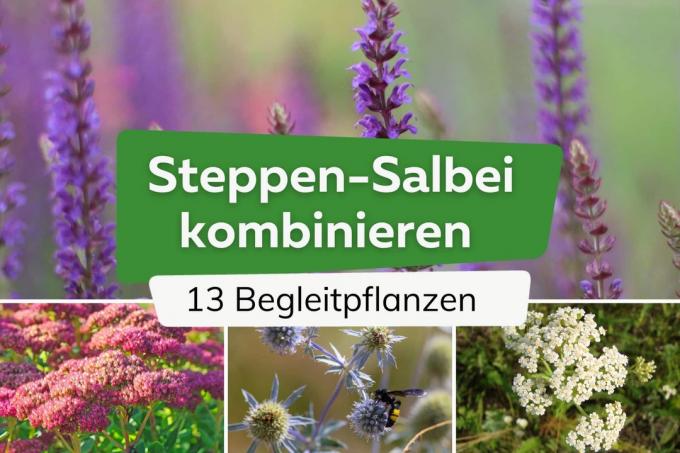
The steppe sage (Salvia nemorosa), also called ornamental sage, fills its surroundings with color and a pleasant scent. It offers an ideal basis for seas of flowers with suitable companion plants. The best combinations can be found here.
To the point
- Ideal companion plants only with similar site conditions
- Pay attention to height and flowering time
- Particularly attractive: companion plants with flower colors of the same color group
- all combination examples also for container planting, with one exception
Table of contents
- Basics
- Location
- Growth height
- flowering time
- The most popular ornamental sage plant neighbors
- B to M
- Companion plants with S
- W to Z
- frequently asked Questions
Basics
When it comes to companion plants to combine for Steppe sage the following must be noted:
Location
Suitable companion plants should be considered those whose demands on their location roughly correspond to those of the steppe sage.
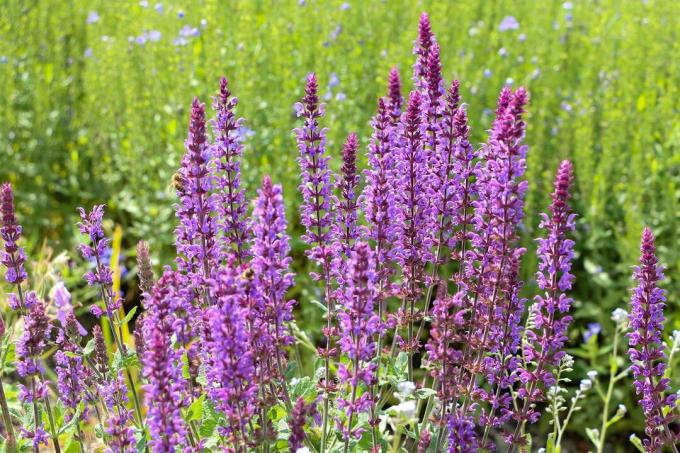
Therefore, companion plants should be able to cope well with the following characteristics:
- sunny, possibly full sun
- permeable, slightly dry to fresh, moderately nutrient-rich soil
- drought tolerant, especially when cultivated in containers
- pH value: around 7.0
Growth height
The height of growth must also be taken into account. Due to its height, the steppe sage could cast up to 60 cm of shade when combined on smaller companion plants, which then receive too little sun and may die. Here you have to pay attention to the direction of the sun and possibly cut back the ornamental sage. The same applies vice versa, because companion plants that are too tall can also deprive the ornamental sage of sunlight.
flowering time
Another aspect is in the flowering period. The ornamental sage blooms in summer, sometimes as early as June. For attractive seas of flowers, steppe sage companion plants should also be chosen with a summer flowering period. Ideally, flower colors should be chosen that match the blue-violet-flowering steppe sage and harmonize with each other.
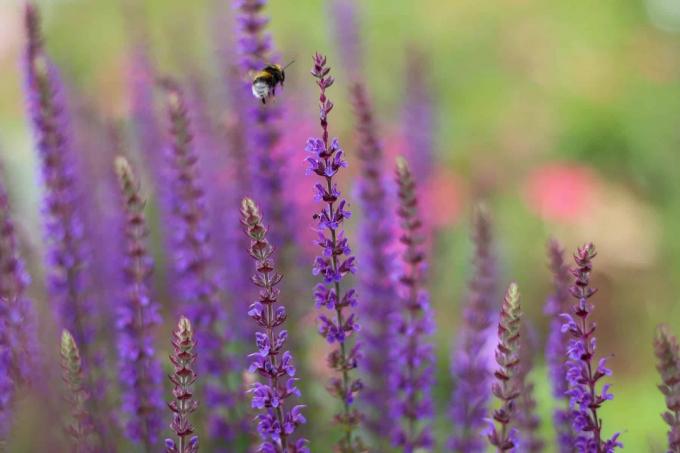
The most popular ornamental sage plant neighbors
Here are the best companion plants for steppe sage that meet the requirements mentioned:
B to M
Beardflower (Caryopteris clandonensis)
The bearded flower is a low to medium-tall subshrub that impresses with its winter hardiness, insect friendliness and low maintenance requirements. It is very compatible with cutting and meets all the requirements for a suitable companion plant for steppe sage in beds and pots.
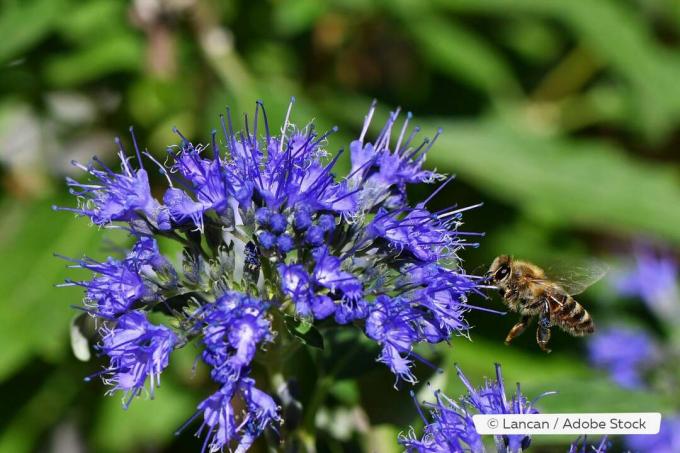
- Growth: compact, shrubby, height between 50 cm and 120 cm
- Blossom: blue, violet, pink, white, July/August to September
floribunda roses (Pink)
Bed roses can be planted in garden beds and containers alongside ornamental sage and are also hardy and perennial. They offer a huge range of colors, the most stylish being shades of pink.

- Growth: shrubby, perennial or ground cover, height 40 cm to 80 cm
- Blossom: pink, red, red, yellow, white, blue, orange; June to October
Tall sedum (Sedum telephium)
The Tall sedum, is available in various shades of pink and red. It is considered very easy to care for, forms a varied contrast to steppe sage due to its growth and is an ideal companion plant in rock gardens and pots.

- Growth: bushy, dense, upright, clumpy, height 30 cm to 60 cm
- Blossom: light to dark pink or red, umbel-shaped, August to October
Globe thistle (Echinops bannaticus)
The ball thistle with flowers from the ornamental sage color group offers a visual highlight. As a companion plant, it fills the bed with decorative charm, but is not suitable as a plant neighbor for potted sage.
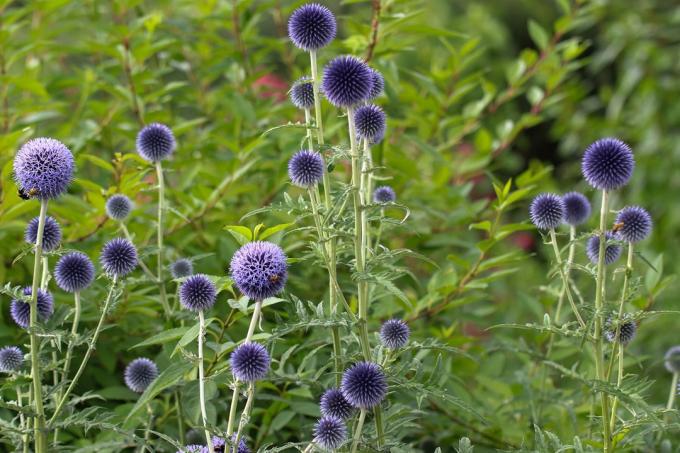
- Growth: upright, clumpy, partly bushy, height 60 cm to 100 cm
- Blossom: light purple-blue to dark or steel blue, spherical blossom, depending on the variety, from June/July or August to September
Girl's eye (coreopsis)
The Girl's eye is one of the most popular garden and Container plants with a long flowering period, which is not only visually appealing, but also provides plenty of food for bees and bumblebees. It should be noted that the girl's eye loves alkaline to acidic soils, so the pH value should be slightly below rather than above 7.0.

- Growth: upright, bushy, height 60 cm to 80 cm
- Blossom: white, yellow, pink, red, orange, plate-shaped, June to October
Companion plants with S
yarrow (Achillea millefolium)
This is a classic in the steppe sage bed or pot yarrow. This is a hardy perennial with large flowers that is very hardy and an insect magnet.
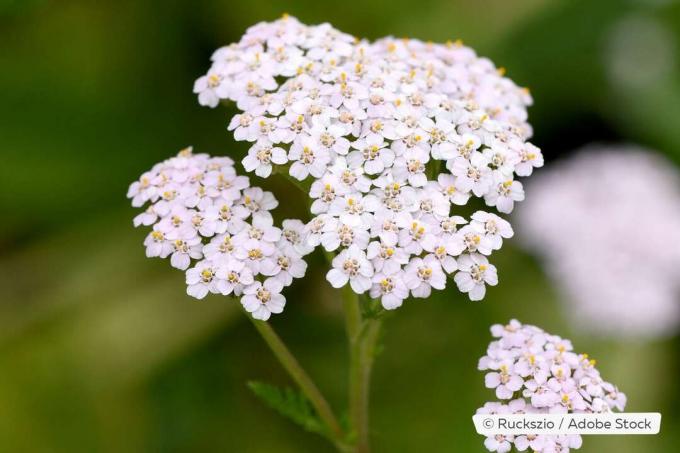
- Growth: loose, clump-forming, upright, height between 40 cm and 60 cm
- Blossom: delicate to dark pink, yellow, white, umbel-shaped, June to August
Gypsophila (Gypsophila)
With the Gypsophila As a plant neighbor, the ornamental sage comes into its own particularly intensively. It is extremely easy to care for, perennial and delights with countless small flowers.
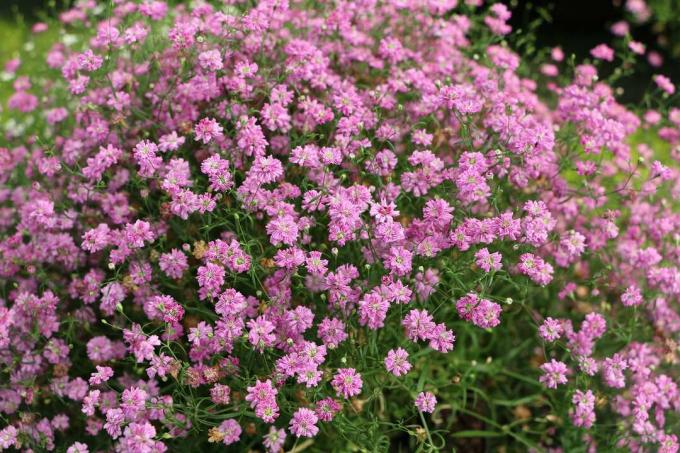
- Growth: perennial, strongly branched, upright up to 100 cm or creeping, ground-covering up to 20 cm high
- Blossom: pink, white or white-pink, panicle or umbel-shaped, creeping May to July, erect July to September
Gypsophila is an ideal way to Cut flowers in a vase to decorate and add a touch of romance, with the white, upright growing gypsophila being the most popular and best suited as a companion plant to ornamental sage.
Sunshine hat (Echinacea purpurea)
Like the steppe sage, the purple and sunshine hat is a stable and particularly flowering perennial. It is ideal as a companion plant, especially for natural gardens.

- Growth: upright, leafy stems, clump-forming, growth height 40 cm to 50 cm
- Blossom: white-yellow, white-green, yellow, pink, red or orange, plate-shaped, July to September
Spur flowers (Centranthus ruber)
As a companion plant to steppe sage, the spur flower is characterized by its special, pyramidal flower shape, which forms a distinctive visual contrast to the sage flowers. It also has a light scent and underlines the varied flair with its gray-green leaves.

- Growth: upright, clumpy, bushy, perennial, height 40 cm to 60 cm
- Blossom: white or red, umbel-like, June to September
Cranesbill (geranium)
In addition to the ornamental sage, it is a real eye-catcher Cranesbill. But be careful, because not all varieties meet the site conditions and bloom at the same time as the steppe sage, especially the cushion-forming varieties.

- Growth: perennial, bushy, upright, clumpy, 40 cm to 50 cm high
- Blossom: white, pink, purple, cup-shaped, depending on the variety between May and August/September
If you want to stay in the blue-violet group in terms of color, Geranium pratense is recommended. It blooms delicately purple and grows up to 70 cm high.
W to Z
Clematis (clematis)
The Clematis is a very popular garden and container plant that can withstand longer dry periods even in the sun. This is a ranking and climbing plant, which is perfect behind steppe sage for walls and facades.
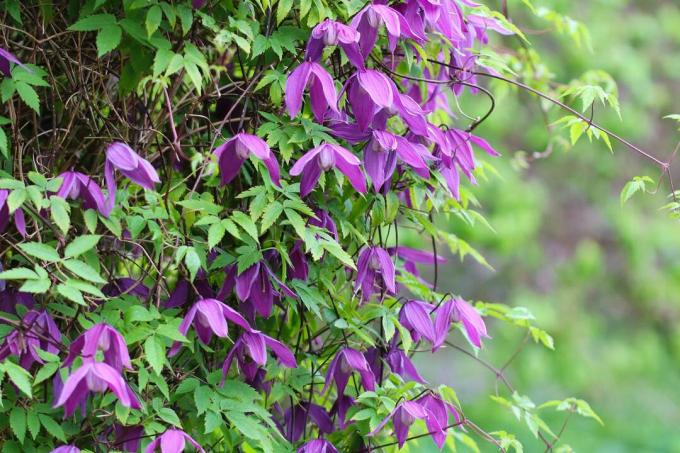
- Growth: trailing, climbing, bushy, height up to 300 cm
- Blossom: yellow, pink, red, violet-purple, cup-shaped, June to September
Scabious flower (Knautia macedonica)
The scabious flower is reminiscent of flowering wild meadows, but can also be planted in small beds or pots. It attracts countless insects and is undemanding, very robust and long-lasting.

- Growth: bushy, clump-forming, compact, height up to 80 cm, width up to 60 cm
- Flowers: colorful, light pink, violet, purple, plate-shaped, between July and September depending on the variety
ornamental grasses
Color accents can also be achieved with ornamental grasses such as riding grass (Calamagrostis) or the feather grass (Stipa) set. In addition, the steppe sage comes into its own.

- Growth: upright to arching, clumpy, height between 40 cm and 180 cm depending on the variety
- Blossoms: green, white, silvery, golden yellow, panicle-shaped, depending on the variety between June and July/August
frequently asked Questions
Yes. The steppe sage is very insect-friendly and is particularly important for bees. With this plant and corresponding insect-friendly companion plants, entire landscapes for bees etc. can be created.
The steppe sage needs at least 30 centimeters of planting distance from its neighbors. However, the planting distance of the companion plants must also be taken into account, which of course could also spread and displace the ornamental sage. Therefore, the larger planting distance that steppe sage or the neighboring plants need is generally applicable.
Real sage (Salvia officinalis) is mainly used as a spice, while ornamental sage is used exclusively for its decorative flowers. Ornamental sage is sprouting again and real sage is becoming woody. In addition, common sage also begins to bloom in June, but it ends in August, while steppe sage blooms well into September.

